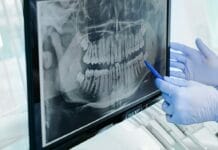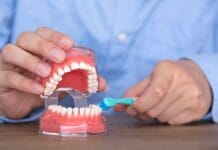As dental hygienists, we often come across various products that promise to improve oral health. One such product category is oral clays, which are becoming increasingly popular due to their natural composition and purported benefits, as well as recent promotion on social media. However, it’s crucial to understand the safety of these products.
I’m unsure of the reason consumers feel the need to add things like sludge, volcanic ash, dirt, and charcoal to oral health products, but it seems appealing to a certain subset of our patients. With influencers on social media promoting products, it puts pressure on dental professionals, especially dental hygienists, to know the details of the products. Are they safe? Are they too abrasive? Is there any benefit to using the product?
With those lingering questions, let’s look at the most recent oral hygiene product being promoted on social media: bentonite clay.
The Question of Bioavailability
In 2016, the U.S. Food and Drug Administration (FDA) warned about elevated levels of lead in bentonite clay products with directions for use that include topical application and oral ingestion. The agency has made some efforts to manage the sales of these products by warning consumers not to purchase or use them. The FDA states that if you have used certain bentonite clay products, consult with a health care professional immediately and report any adverse events related to their use.1,2 However, the products are making a comeback with claims of detoxifying and improving oral health.
The claims made by these companies and the influencers pushing them are that bentonite clay acts as a detoxifying agent and improves oral health through a not well-defined detoxification process. However, the FDA reports of elevated lead levels in bentonite clay have forced the influencers and manufacturers making these products to explain their product’s safety.1-3
Manufacturers of bentonite clay-containing oral care products claim that lead is not bioavailable when ingested or applied to the oral mucosa. This claim has been extrapolated from the way bentonite clay binds to lead in water. It is often used in wastewater to remove lead and other toxins for safer drinking water.1-3
However, lead and other heavy metals do become bioavailable in the human body when ingested or applied to the skin or mucosa. The complexity of the human body contributes to the absorption of lead from bentonite clay, unlike the simplistic elements of water.4
Risks of Metals in Clay
Unfortunately, lead is not the only concern in bentonite clay. A study conducted by Reeuwijk and colleagues in 2013 provides valuable insights into this matter. The researchers analyzed various oral bentonite clays available in the Dutch market for the presence of four heavy metals: lead, arsenic, mercury, and cadmium.5
The study found that these oral bentonite clays did contain varying levels of these heavy metals. The presence of these metals is concerning due to their potential health risks when ingested over time. For instance, lead and mercury can affect the nervous system, while arsenic and cadmium have been linked to various types of cancer.5
In another study, researchers focused on the presence of two heavy metals ‒ arsenic and lead ‒ in “healing” clay used topically. The findings revealed that the “healing” clay contained elevated levels of both arsenic and lead. As mentioned, these heavy metals can be absorbed through the skin and mucosa or ingested accidentally, potentially posing significant health risks.6
No Safe Levels of Lead
The confounding thing is that most people seeking bentonite clay as an alternative to standard toothpaste are looking to avoid fluoride. Though fluoride does pose some neurotoxic effects at high levels, it is perfectly safe at the levels found in toothpaste, whereas there is no safe level of lead.7 Additionally, the FDA regulates and approves toothpaste, unlike bentonite clay products. If your patient is staunchly anti-fluoride, OTC non-fluoridated toothpastes are available and are regulated by the FDA, which would be a much safer option.
Although the manufacturers and influencers have made bold claims about the lack of bioavailability of lead from the use of bentonite clay, the biology of the human body and the interactions and pathways that sustain life indicate otherwise. The interaction between heavy metals and micronutrients increases absorption. For instance, a low-protein diet increases the absorption of cadmium. In comparison, vitamin D increases the intestinal absorption of lead. Lead also competes with multiple micronutrients, leading to deficiencies in iron and calcium, which can increase lead levels in bone and increase the risk of hemolytic anemia.8,9
The micronutrients that lead depletes are also important in maintaining oral health, indicating that using bentonite clay is likely not beneficial for oral health and is especially not beneficial to overall health. I didn’t explore benefits further because the risk of being exposed to lead alone outweighs any benefits that might be achievable by using bentonite clay for oral health.10
Advising Dental Patients
The main reason to avoid bentonite clay as a toothpaste alternative is due to the high levels of heavy metals. Bentonite clay is not abrasive as it is 1.5 to 2.0 on the Mohs hardness scale, making it less abrasive than plain baking soda.11
Therefore, it’s crucial to advise our patients to choose their oral care products wisely, considering not only the promised benefits but also the potential risks. Encouraging them to opt for products that have been tested for safety and comply with health regulations can go a long way in ensuring their oral and overall health.
In Closing
While the natural appeal of bentonite clay can be enticing, it’s our responsibility as dental hygienists to ensure that our patients are aware of the potential risks associated with their use, particularly concerning heavy metal exposure. It is important to consider the appeal to the naturalistic fallacy. This is when something is claimed to be good because it is perceived as “natural.” Natural does not equate to safe.
Staying informed about such research allows us to provide the best possible advice to our patients, contributing to their overall health and well-being.
Before you leave, check out the Today’s RDH self-study CE courses. All courses are peer-reviewed and non-sponsored to focus solely on pure education. Click here now.
Listen to the Today’s RDH Dental Hygiene Podcast Below:
References
- FDA Warns Consumers Not to Use “Best Bentonite Clay.” (2016, March 23). U.S. Food & Drug Administration. https://www.fda.gov/drugs/drug-safety-and-availability/fda-warns-consumers-not-use-best-bentonite-clay
- FDA Warns Consumers About Health Risks with Alikay Naturals – Bentonite Me Baby – Bentonite Clay. (2016, March 23). U.S. Food & Drug Administration. https://www.fda.gov/drugs/drug-safety-and-availability/fda-warns-consumers-about-health-risks-alikay-naturals-bentonite-me-baby-bentonite-clay
- Khan, M. Adsorption of Lead by Bentonite Clay. International Journal of Scientific Research & Management Studies. 2017; 5(7): 5800-5804. https://www.researchgate.net/publication/318288202_Adsorption_of_Lead_by_Bentonite_Clay
- What Are Routes of Exposure to Lead? (2023, May 24). Agency for Toxic Substances and Disease Registry. https://www.atsdr.cdc.gov/csem/leadtoxicity/exposure_routes.html
- Reeuwijk, N.M., Klerx, W.N., Kooijman, M., et al. Levels of Lead, Arsenic, Mercury and Cadmium in Clays for Oral Use on the Dutch Market and Estimation of Associated Risks. Food Addit Contam Part A Chem Anal Control Expo Risk Assess. 2013; 30(9): 1535-1545. https://pubmed.ncbi.nlm.nih.gov/23862762/
- Whiteside, T.E., Qu, W., DeVito, M.J., et al. Elevated Arsenic and Lead Concentrations in Natural Healing Clay Applied Topically as a Treatment for Ulcerative Dermatitis in Mice. J Am Assoc Lab Anim Sci. 2020; 59(2): 212-220. https://pubmed.ncbi.nlm.nih.gov/32059757/
- What Are Possible Health Effects From Lead Exposure? (2023, May 27). Centers for Disease Control and Prevention. https://www.atsdr.cdc.gov/csem/leadtoxicity/physiological_effects.html
- Peraza, M.A., Ayala-Fierro, F., Barber, D.S., et al. Effects of Micronutrients on Metal Toxicity. Environmental Health Perspectives. 1998; 106(Suppl. 1): 203-216. https://doi.org/10.1289/ehp.98106s1203
- Albalawi, O., Almubark, R., Almarshad, A., Alqahtani, A.S. The Prevalence of Vitamin and Mineral Deficiencies and High Levels of Non-Essential Heavy Metals in Saudi Arabian Adults. Healthcare. 2022; 10(12): 2415. https://doi.org/10.3390/healthcare10122415
- Kaur, K., Sculley, D., Wallace, J., et al. Micronutrients and Bioactive Compounds in Oral Inflammatory Diseases. Journal of Nutrition & Intermediary Metabolism. 2019; 18: 100105. https://www.sciencedirect.com/science/article/pii/S2352385919300210
- Bentonite. (2022, May 2). Cameo Materials Database. https://cameo.mfa.org/wiki/Bentonite












